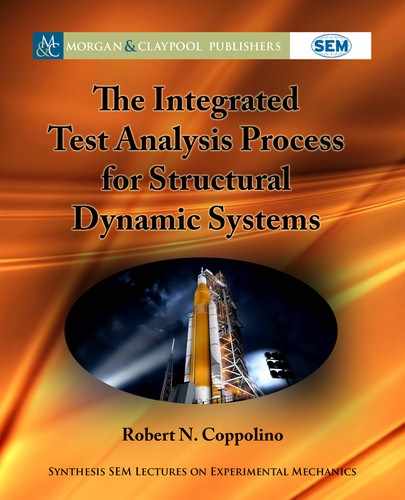
138 7. RECONCILIATION OF FINITE ELEMENT MODELS AND MODAL TEST DATA
Table 7.3: Summary of FEM parameters adjusted for reconciliation
TSS02
Update ValueOriginal ValueDescriptionParameter Update Value Update Value % Change% Change% Change
TSS04 TSS17
Table 7.4: ISS P5 data sets TSS2, TSS4, and TSS17 test to updated FEM NASA-STD-5002
compliance status
TSS02
Mode Post-Test (Hz) ∆F (%)Test (Hz) COR (%) Post-Test (Hz) ∆F (%)Test (Hz) COR (%) Post-Test (Hz) ∆F (%)Test (Hz) COR (%)Freq (Hz)
Pre-Test
Comments
Satisfies NASA STD-5002 Modal Frequency
and On-Diagonal Cross-Orthogonality Goals
Satisfies NASA STD-5002 Modal Frequency
and On-Diagonal Cross-Orthogonality Goals
Frequency Band associated with Reduced
MI/MO Coherence (Strong Nonlinearity)
TSS04 TSS17
7.2.5 ILLUSTRATIVE EXAMPLE: ISPE MODAL TEST
While ISPE FEM-test reconciliation activities have been the responsibility of NASA/MSFC,
it is of interest here to engage in an independent hypothetical exercise that employs RMA sen-
sitivity and modal cost function (norm) minimization methodology tools. A hypothetical pair
of single parameter mass and stiffness sensitivity matrices, which are “rigged” to effect perfect
test-analysis correlation (ISPE modes in the 0–65 Hz band) for a unit value of the sensitivity
parameter, p, are defined. While the ISPE modes estimated with SFD-2018 are complex, the
target test modes for the present exercise are the real parts of those modes.
Migration of ISPE modal frequencies, presented in Figure 7.8, illustrates the capability of
RMA to track substantial modal frequency changes associated with large parametric variation
(as previously noted in Figure 7.1). Large modal frequency variations with “cross-overs” cannot
be adequately tracked through the use of exact and approximate modal derivatives.
Results of Monte Carlo based minimization of the single-parameter-based modal cost
function search analysis, and a summary of ISPE original TAM, reconciled TAM, and SFD-
2018 test modal frequencies, respectively, are summarized are illustrated in Figure 7.9.
Displays of SFD-2018 test mode orthogonality, TAM-test mode cross-orthogonality, and
TAM-test modal coherence, for the original and reconciled TAMs are illustrated in Figure 7.10.
Please note that the above ISPE model correlation and reconciliation exercise represents
an idealized hypothetical process. Official ISPE model correlation and reconciliation results,
performed by NASA/MSFC, are not presented in this book.

7.2. PART 2: TEST-ANALYSIS RECONCILIATION 139
40
35
30
25
20
15
0.985 0.99 0.995 1 1.005 1.01 1.015
Modal Frequencies (Hz)
Parameter (p)
0.985 0.99 0.995 1 1.005 1.01 1.015
Parameter (p)
ISPE Modal Sensitivity: 15–40 Hz Band ISPE Modal Sensitivity: 40–65 Hz Band
65
60
55
50
45
40
Modal Frequencies (Hz)
Figure 7.8: Migration of ISPE modal frequencies due to parametric variation.
35
30
25
20
15
10
5
0
0.985 0.99 0.995 1 1.005 1.01 1.021.015
Error Norm
Frequencie (Hz)
Parameter
0 10 20 30 40 50 60
Parameter
60
50
40
30
20
10
0
Trials
Optimum
Original TAM
Reconciled TAM
SFD-2018 Test
Figure 7.9: ISPE modal cost error norm and ISPE modal frequency summary.

140 7. RECONCILIATION OF FINITE ELEMENT MODELS AND MODAL TEST DATA
Original TAM-Test Correlation
Original Test Mode Orthogonality Original TAM-Test Mode Cross-Orthogonality Original TAM-Test Modal Coherence
Reconciled TAM-Test Correlation
Final Test Mode Orthogonality Final TAM-Test Mode Cross-Orthogonality Final TAM-Test Modal Coherence
10
20
30
40
50
60
Test
10
20
30
40
50
60
100
90
80
70
60
50
40
30
20
10
90
80
70
60
50
40
30
20
10
90
80
70
60
50
40
30
20
10
TAM
10
20
30
40
50
60
Test
10
20
30
40
50
60
Test
10
20
30
40
50
60
100
90
80
70
60
50
40
30
20
10
90
80
70
60
50
40
30
20
10
90
80
70
60
50
40
30
20
10
TAM
10
20
30
40
50
60
Test
605040302010
Test
605040302010
Test
605040302010
Test
605040302010
Test
605040302010
Test
605040302010
Test
Figure 7.10: Original (pre-test) and reconciled TAM-Test correlation matrices.
7.2.6 ILLUSTRATIVE EXAMPLE: WIRE ROPE TEST ARTICLE
While the wire rope test article, discussed in Chapter 4, is not a modal test-correlation and
reconciliation application, it provides an example of detailed nonlinear system identification
for a dynamic system that possesses strong hysteretic behavior. It is instructive at this point
to recall results of preliminary data analysis and nonlinear MI/SO spectral analysis that were
presented in Chapter 4. Preliminary data analysis of the estimated isolator deflection and isolator
internal force probability density functions is summarized, along with a photograph of the test
configuration, in Figure 7.11.
e hypothesized “algebraic” nonlinear system composed of measured time histories (ap-
plied force and acceleration response) and synthesized “measured” time histories (cubed dis-
placement and velocityjvelocityj) depicted in Figure 7.12 was subjected to MI/SO analysis.
e cumulative coherence plot, shown in Figure 7.13 indicates that incorporation of the
two nonlinear terms produces a nearly unit value cumulative coherence (red curve), while the
ordinary coherence associated with a linear model (blue curve) indicates reduced coherence.
While the above results provide clear evidence that the behavior of the wire rope isolators
is nonlinear, closer examination of isolator response to swept-sine excitation suggests the wire

7.2. PART 2: TEST-ANALYSIS RECONCILIATION 141
Enidine WR2-200-108
Wire-Rope Isolators
Figure 7.11: Wire rope isolators subjected to broadband random excitation.

142 7. RECONCILIATION OF FINITE ELEMENT MODELS AND MODAL TEST DATA
F
U
F(t)
(U(t))
3
U̇(t) ∙ |U̇(t)|
Ü(t)
H
1
H
2
H
3
Figure 7.12: Hypothesized MI/SO nonlinear system.
File: WireNonR…MI/MO: Navg=29, df=0.488, MI/SO Cumulative Coherence
1
0.9
0.8
0.7
0.6
0.5
0.4
0.3
0.2
0.1
0
10 15 20 25 30 35 40 5045
Hz
Cumulative Coherence
Due to Force
Due to Force + U2Z
3
Due to Force + U2Z
3
+ V 3Z*|V 3Z|
Figure 7.13: Hypothesized nonlinear system cumulative coherence.
..................Content has been hidden....................
You can't read the all page of ebook, please click here login for view all page.
